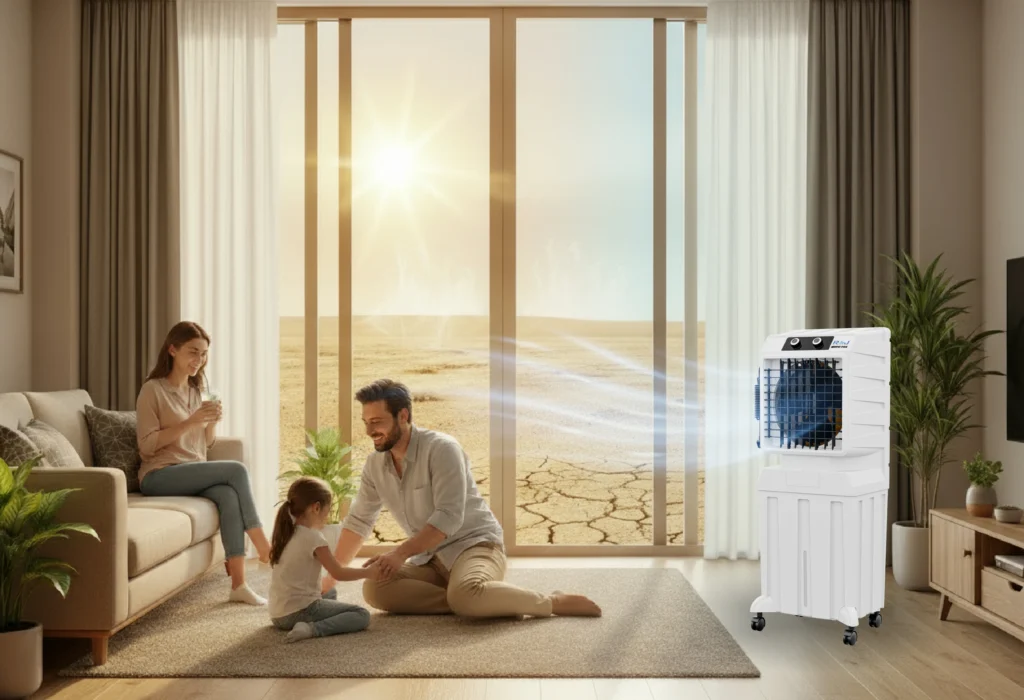Imagine stepping outside on a blazing summer afternoon. The air is dry, your throat feels thirsty, and even the wind feels like it’s coming from a hot furnace. In this kind of heat, staying comfortable isn’t just about cooling the air it’s about finding the right cooling method for your climate.
Most people quickly think of air conditioners, but there’s another option that works better in dry regions: air coolers. Unlike ACs, which fight against the climate, air coolers actually use it to their advantage.
In dry areas, where the air has very little moisture, air coolers don’t just work, they perform at their best. Their secret is something called evaporative cooling, the same natural process your body uses when you sweat to cool down. Understanding this simple science shows why air coolers are not only cheaper to run but also better for your health, easier on your wallet, and kinder to the environment.
The Science of Evaporative Cooling
Evaporative cooling is nature’s own way of reducing heat. It occurs when water changes from liquid to vapor, absorbing heat energy from its surroundings in the process. A simple example of this is sweating. When you sweat, the moisture on your skin evaporates, carrying away heat and naturally cooling your body. Air coolers work on this same principle. They draw in hot, dry air from the environment and pass it through wet cooling pads. As the water in these pads evaporates, it reduces the temperature of the air. The built-in fan then blows this freshly cooled and slightly humidified air into the room, providing instant relief. Unlike air conditioners, which recycle the same indoor air, air coolers continuously circulate fresh, filtered air, making your surroundings feel healthier and more comfortable.
Why Dry Climates Are Ideal for Air Coolers
The effectiveness of evaporative cooling depends largely on the moisture content of the air. In dry climates, where the humidity level is low, the air can easily absorb water vapor, which results in faster evaporation and more efficient cooling. This is why air coolers work incredibly well in hot and arid regions. On the other hand, in areas with high humidity, the air is already saturated with moisture, which slows down the evaporation process and limits the cooler’s performance. States like Rajasthan, Gujarat, and parts of Madhya Pradesh are perfect examples of regions where air coolers deliver outstanding results because of the dry weather conditions. In such places, air coolers not only provide powerful cooling but also make the environment more comfortable by adding a touch of humidity to the air.
Advantages of Using Air Coolers in Dry Climates
Air coolers offer a range of practical benefits, especially in dry regions. They are a natural and eco-friendly cooling solution since they don’t use harmful refrigerants or chemicals. The slight moisture they add to the air helps combat issues caused by dryness, such as skin irritation, allergies, and breathing discomfort. Another major advantage is their energy efficiency air coolers consume up to 80% less electricity than air conditioners, which significantly lowers energy bills during long summers. They are also cost-effective to install and maintain, as they don’t require complicated systems like compressors or extensive piping. With simple maintenance like cleaning and pad replacements, an air cooler can last for many years while providing consistent, natural cooling.
Air Coolers vs. ACs in Dry Climates
While both air coolers and air conditioners aim to provide relief from heat, they work very differently and have varying effects in dry climates. Air conditioners use refrigeration to cool and recirculate the same indoor air, which often worsens dryness by removing moisture from the room. This can lead to dehydration, dry skin, and irritation over time. In contrast, air coolers add moisture to the air, naturally balancing dryness while continuously supplying fresh air from outside. They are also far more energy-efficient, making them a better choice for both your wallet and the environment. For households in dry regions, air coolers not only deliver effective cooling but also promote healthier living conditions.
Tips to Maximize Air Cooler Performance in Dry Areas
To get the most out of your air cooler, proper setup and maintenance are essential. Always keep windows or doors slightly open to allow cross-ventilation, which helps the cooler circulate fresh air effectively. Use clean water and replace it regularly to maintain hygiene and ensure efficient cooling. The cooling pads should also be cleaned and replaced periodically to prevent dust buildup and maintain smooth operation. Placing the cooler near open spaces like windows or balconies can further improve airflow and enhance overall performance.
Conclusion
Air coolers are a perfect blend of affordability, eco-friendliness, and efficiency, making them the ideal cooling solution for hot and dry climates. By harnessing the natural process of evaporative cooling, they deliver fresh, cool air while consuming minimal energy. Unlike air conditioners, they improve indoor air quality by adding a touch of moisture, keeping you comfortable even during the driest summer days. If you’re looking to beat the heat this season, explore Raj Cooling Systems’ wide range of air coolers, designed to deliver maximum comfort while caring for both your health and the environment.

